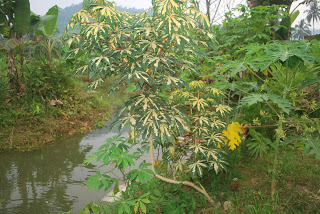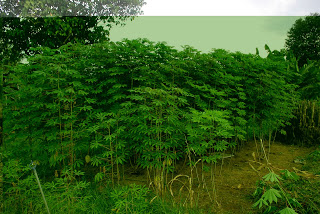Being a small farmer Part 2 – Setting the basics
I am often asked to explain what type of a farm I have and I find it difficult to define it within the more prevalent terms so I created my own term: a natural integrated farm. At the heart of it, we strive to make the most use out of nature within the farm operations
 To start with, 2 separate polypipes are used to transport water from two separate sources, clean and natural water sources. One polypipe provides for the water for household and agriculture use and the other pipe is strictly for the fish ponds for aquaculture use. This ensures that water flows through the ponds 24 hours a day enabling the constant removal of any aquaculture waste and providing for good oxygenation of the pond, critical elements in rearing fish. From an aesthetic value, the pond does not produce noxious odors and the sound of the water creates a calming environment.
To start with, 2 separate polypipes are used to transport water from two separate sources, clean and natural water sources. One polypipe provides for the water for household and agriculture use and the other pipe is strictly for the fish ponds for aquaculture use. This ensures that water flows through the ponds 24 hours a day enabling the constant removal of any aquaculture waste and providing for good oxygenation of the pond, critical elements in rearing fish. From an aesthetic value, the pond does not produce noxious odors and the sound of the water creates a calming environment.
The land clearing was done manually and selective bull-dozing, taking care to preserve as much of the top soil as possible.
 Being situated in a water catchment area where there is plenty of rainfall, it was important to have facilities to provide for water run-off and a flood prevention mechanism, hence the ponds also serve this purpose. The pond is built on the dried stream bed hence its shape is similar to a stream with the outflow going into Sg. Lui. This is where I will start our aquaculture project of rearing fresh water fish. With this in mind, it was imperative that no chemical herbicides or pesticides is used at the farm to prevent this being introduced into the ponds and ultimately into the fish, With the great water quality, it would be almost criminal to contaminate the pond and the fish. Whilst people who consume the fish may not be aware of any minute amounts of chemical toxins, I would know and this would go against my principle: I only sell produce that I would eat.
Being situated in a water catchment area where there is plenty of rainfall, it was important to have facilities to provide for water run-off and a flood prevention mechanism, hence the ponds also serve this purpose. The pond is built on the dried stream bed hence its shape is similar to a stream with the outflow going into Sg. Lui. This is where I will start our aquaculture project of rearing fresh water fish. With this in mind, it was imperative that no chemical herbicides or pesticides is used at the farm to prevent this being introduced into the ponds and ultimately into the fish, With the great water quality, it would be almost criminal to contaminate the pond and the fish. Whilst people who consume the fish may not be aware of any minute amounts of chemical toxins, I would know and this would go against my principle: I only sell produce that I would eat.
 The selection of what was to be planted at the farm was also important in order to provide a balanced environment. The first plants planted was banana plants. This plant consumes a lot of water so it helps to absorb the water from the rains. At the farm, only natural banana plants are planted which means that we do not plant any genetically-modified (GM) plants or plants from culture tissues. In Malaysia, we have an abundance of variety of banana plants and I am on a quest to have all the varieties of bananas available at the farm. This is my personal conservation effort to preserve our heritage. It would be a shame to lose it and for us to become a GM culture and not be aware of the richness of varieties available. Apart from being harvested for the bananas, the inflorescence is also harvested prior to the bananas and this is a great ulam or “vegetable” which has many health benefits based on our traditional medicine practitioners. The inner portion of the pseudostem is used as a supplementary food for the fish as well as serving as a pond water natural cleansing agent. Sometimes, we consume the inner portion of the stem as one of the ingredients in a curry. The remaining portions of the plant after harvesting the fruit is turned into a compost providing for a natural fertilizer. Hence from this one type of plant, it serves multiple purposes and provides a multitude of benefits naturally.
The selection of what was to be planted at the farm was also important in order to provide a balanced environment. The first plants planted was banana plants. This plant consumes a lot of water so it helps to absorb the water from the rains. At the farm, only natural banana plants are planted which means that we do not plant any genetically-modified (GM) plants or plants from culture tissues. In Malaysia, we have an abundance of variety of banana plants and I am on a quest to have all the varieties of bananas available at the farm. This is my personal conservation effort to preserve our heritage. It would be a shame to lose it and for us to become a GM culture and not be aware of the richness of varieties available. Apart from being harvested for the bananas, the inflorescence is also harvested prior to the bananas and this is a great ulam or “vegetable” which has many health benefits based on our traditional medicine practitioners. The inner portion of the pseudostem is used as a supplementary food for the fish as well as serving as a pond water natural cleansing agent. Sometimes, we consume the inner portion of the stem as one of the ingredients in a curry. The remaining portions of the plant after harvesting the fruit is turned into a compost providing for a natural fertilizer. Hence from this one type of plant, it serves multiple purposes and provides a multitude of benefits naturally.
 Since I foresee that there will be times when I will be too tired to drive home, I decided that I needed to have a house built but one with is functional to farm operations, easy to keep clean, comfortable and with lots of natural light. I do not foresee working the farm alone so I designed the house to accomodate my workers too. I use a lot of tiles all over the place – all the floors, the kitchen counters, most of the walls and to allow for privacy yet allowing for natural light, most walls have glass tile cubes. Skylights are also strategically for more natural lighting. All around the house, just below the roof, a 2 ft. lattice “wall” allows for fresh air to constantly circulate into the house. The detail work on the house is still being done as the primary focus is the farm but I hope it will be completed before end of this year – my birthday present to myself.
Since I foresee that there will be times when I will be too tired to drive home, I decided that I needed to have a house built but one with is functional to farm operations, easy to keep clean, comfortable and with lots of natural light. I do not foresee working the farm alone so I designed the house to accomodate my workers too. I use a lot of tiles all over the place – all the floors, the kitchen counters, most of the walls and to allow for privacy yet allowing for natural light, most walls have glass tile cubes. Skylights are also strategically for more natural lighting. All around the house, just below the roof, a 2 ft. lattice “wall” allows for fresh air to constantly circulate into the house. The detail work on the house is still being done as the primary focus is the farm but I hope it will be completed before end of this year – my birthday present to myself.
 Of course no farm is complete without some animals – other than the fish. I started my initial stock of kampung chicken which I obtained from Kedah and later added more from my neighbour. These are free-range chicken so they wonder all around the farm, eating their fill. Another reason why no chemical pesticides or herbicides are used. From my initial stock of 4 chickens, we currently have a total of about 60 chickens which I hope to further increase in the coming months. They also serve to keep the insects at bay as well as helping with controlling the weeds and grass.
Of course no farm is complete without some animals – other than the fish. I started my initial stock of kampung chicken which I obtained from Kedah and later added more from my neighbour. These are free-range chicken so they wonder all around the farm, eating their fill. Another reason why no chemical pesticides or herbicides are used. From my initial stock of 4 chickens, we currently have a total of about 60 chickens which I hope to further increase in the coming months. They also serve to keep the insects at bay as well as helping with controlling the weeds and grass.
With all the different practices utilizing nature, this gave birth to our tag line: Maximizing Nature’s Bounty. More tales to follow so watch out for the next segment.








































